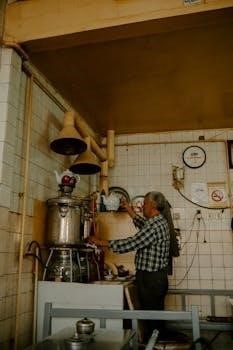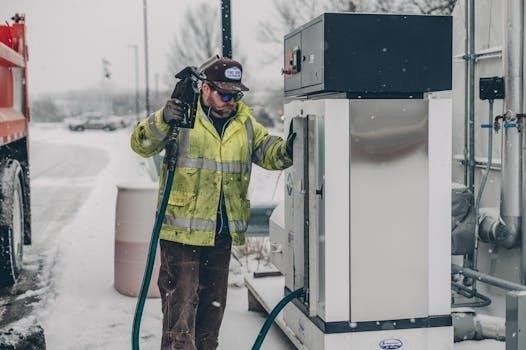
chinese diesel heater manual pdf
Chinese Diesel Heater Manual PDF⁚ A Comprehensive Guide
Welcome! This comprehensive guide serves as your go-to resource for navigating the world of Chinese diesel heaters․ We aim to provide clear‚ concise instructions and helpful tips in an easily accessible PDF format․ Whether you’re a first-time user or a seasoned pro‚ this manual will enhance your understanding and usage․
Chinese diesel heaters have surged in popularity as a cost-effective heating solution for various applications‚ including RVs‚ vans‚ workshops‚ and even boats․ These compact and efficient heaters offer a practical alternative to more expensive heating systems‚ providing warmth and comfort in diverse environments․ Their affordability and relatively simple design make them attractive to DIY enthusiasts and budget-conscious consumers․
However‚ it’s crucial to acknowledge that these heaters‚ often manufactured in China‚ can sometimes lack the detailed documentation and support found with established brands․ This is where a comprehensive understanding of their operation becomes essential․ These heaters typically run on diesel fuel and require a 12V or 24V power supply‚ depending on the model․ They function by combusting diesel fuel in a controlled environment‚ generating heat that is then circulated via a fan․
While offering excellent value‚ it’s vital to approach their use with a degree of caution․ Understanding the specific model’s nuances‚ potential safety considerations‚ and troubleshooting techniques is paramount․ By familiarizing yourself with these aspects‚ you can ensure safe and efficient operation․ This guide will help you navigate the intricacies of Chinese diesel heaters․
Understanding the Control Panel and Remote
The control panel and remote are your primary interfaces for operating the Chinese diesel heater․ Familiarizing yourself with their functions is essential for efficient use․ Control panels vary‚ but most feature an LCD screen displaying temperature‚ error codes‚ and other relevant information․ Common buttons include power‚ up/down arrows for temperature adjustment‚ and a mode selection button to switch between automatic and manual operation․
The remote typically mirrors the control panel’s functions‚ offering added convenience․ Some remotes include timer settings‚ allowing you to schedule heater operation․ Understanding the symbols and icons on both the control panel and remote is crucial․ For instance‚ a fan icon often indicates fan speed settings‚ while a flame icon represents the heater’s combustion status․
Many users find the included instructions lacking; therefore‚ experimentation and online resources often become necessary․ Pay close attention to how the heater responds to different settings‚ and keep a record of what works best for your needs․ Some remotes also allow you to toggle between displaying temperature in Celsius or Fahrenheit․ Proper understanding ensures optimal performance and control over your heating environment․
Initial Setup and Pre-Operation Checklist
Before firing up your Chinese diesel heater‚ a proper initial setup and pre-operation checklist are vital for safety and optimal performance․ Begin by selecting a suitable location‚ ensuring adequate ventilation and clearance from flammable materials․ Mount the heater securely‚ following the manufacturer’s instructions‚ paying close attention to the exhaust pipe routing․ It’s best practice to position the exhaust pipe on a slight downward slope to allow condensation to drain․
Next‚ assemble the fuel system‚ connecting the fuel tank to the heater using the provided fuel lines․ Ensure all connections are tight to prevent leaks․ Connect the heater to a 12V or 24V power source‚ depending on your model‚ verifying proper polarity․
Before the first start‚ perform a thorough check⁚ confirm all electrical connections are secure‚ verify the fuel lines are free from kinks or obstructions‚ and ensure the exhaust pipe is properly installed and vented outside․ Fill the fuel tank with clean diesel fuel with a cetane rating of at least 45‚ avoiding biodiesel or additives․ Finally‚ double-check the heater’s settings and familiarize yourself with the control panel functions․ This meticulous approach minimizes potential issues․
Starting the Heater⁚ A Step-by-Step Guide

Once you’ve completed the initial setup and pre-operation checklist‚ you’re ready to ignite your Chinese diesel heater․ This step-by-step guide will walk you through the starting process․ First‚ ensure the heater is connected to a reliable power source‚ either a fully charged battery or an external power supply‚ matching the voltage requirements (12V or 24V) of your specific heater model․ Locate the power switch on the control panel and turn it on‚ initiating the system․
Next‚ prime the fuel system․ Some heaters require manual priming‚ involving pumping fuel into the combustion chamber until it reaches the heater․ If equipped with an automatic priming function‚ activate it through the control panel․ Allow sufficient time for the fuel to reach the burner․ Once primed‚ set the desired temperature or power level using the control panel or remote․ Initiate the startup sequence by pressing the “on” button․ The heater will begin an ignition cycle‚ which includes the glow plug heating up and the fan starting․
Be patient; the initial startup may take a few minutes․ If the heater fails to start after several attempts‚ consult the troubleshooting section․ Once running‚ monitor the heater for any unusual noises or smells․
Operating Modes⁚ Automatic vs․ Manual
Chinese diesel heaters typically offer two distinct operating modes⁚ automatic and manual․ Understanding the difference between these modes is crucial for optimizing your heating experience and conserving fuel․ Automatic mode‚ often referred to as temperature control mode‚ allows you to set a target temperature for your space․ The heater will then automatically adjust its power output to maintain that temperature‚ cycling on and off as needed․
This mode is ideal for maintaining a consistent and comfortable environment with minimal user intervention․ In contrast‚ manual mode provides direct control over the heater’s power level or fan speed․ This allows you to set a specific heat output‚ regardless of the ambient temperature․ Manual mode is useful when you need a constant heat output for a specific task‚ like drying gear or preventing freezing․ It also provides more control in situations where temperature fluctuations are acceptable․
To switch between modes‚ consult your control panel’s instructions․ Some models use a dedicated button‚ while others require navigating a menu․ Consider your heating needs and environment when selecting the appropriate mode․ Automatic is best for consistent comfort‚ while manual offers greater control over heat output․

Fuel Selection and Fuel System Priming
Proper fuel selection is paramount for the reliable operation and longevity of your Chinese diesel heater․ These heaters are designed to run on clean diesel fuel with a cetane rating of at least 45․ Using fuel with a lower cetane rating can lead to incomplete combustion‚ reduced efficiency‚ and increased emissions․ Avoid using biodiesel or diesel fuel with additives unless explicitly approved by the heater manufacturer․
Biodiesel can cause corrosion and damage to the fuel system components․ Fuel system priming is a crucial step‚ especially after initial installation or when the fuel tank has run dry․ Priming ensures that the fuel line and pump are free of air and that fuel is readily available for combustion․ The priming procedure typically involves activating the fuel pump manually through the control panel․ You may hear a clicking sound as the pump draws fuel from the tank․
Continue priming until you observe fuel flowing through the transparent fuel line‚ free of air bubbles․ Some heaters have a dedicated priming mode‚ while others require repeated on/off cycles of the heater․ Refer to your specific heater’s manual for the precise priming procedure․ Proper fuel selection and thorough fuel system priming are essential for trouble-free operation․
Troubleshooting Common Error Codes

Chinese diesel heaters‚ while generally reliable‚ can sometimes display error codes․ These codes are designed to help diagnose potential issues and guide you toward a resolution․ Understanding these codes is essential for maintaining optimal heater performance․ One common error code relates to low fuel levels․ If the heater detects insufficient fuel‚ it may shut down and display an error․ Ensure that the fuel tank has an adequate supply of clean diesel fuel․
Another frequent error involves blocked air intake or exhaust․ Check these areas for obstructions such as debris‚ snow‚ or ice․ A faulty glow plug can also trigger an error code․ The glow plug is responsible for igniting the fuel during startup․ If it fails‚ the heater will struggle to start and may display an error․ Low voltage can also cause problems․ Ensure the heater is connected to a stable 12V or 24V power source with sufficient amperage․
Consult your heater’s manual for a comprehensive list of error codes and their corresponding solutions․ Often‚ a simple reset can clear the error after addressing the underlying issue․ If the problem persists‚ further diagnostics or professional assistance may be required․
Adjusting Fuel/Air Ratio for Altitude
Operating a Chinese diesel heater at varying altitudes requires careful adjustment of the fuel/air ratio․ As altitude increases‚ the air becomes thinner‚ containing less oxygen․ This can lead to incomplete combustion‚ resulting in reduced efficiency‚ increased soot production‚ and potential damage to the heater․ To compensate for the reduced oxygen levels‚ the fuel supply needs to be decreased․ This ensures a more balanced fuel/air mixture for optimal combustion․
The adjustment process typically involves modifying the heater’s control settings․ Some models have a dedicated altitude adjustment feature‚ while others require manual calibration of the fuel pump․ Consult your heater’s manual for specific instructions on how to adjust the fuel/air ratio for your model․ It is crucial to make small‚ incremental adjustments and monitor the heater’s performance closely․
Signs of an improperly adjusted fuel/air ratio include excessive smoke‚ poor heating performance‚ and unusual odors․ If you observe any of these symptoms‚ readjust the fuel/air ratio until the heater operates smoothly and efficiently․ It’s also advisable to consult online forums or communities dedicated to Chinese diesel heaters for altitude adjustment tips specific to your location․
Safety Precautions and Maintenance Tips
Operating a Chinese diesel heater safely requires adherence to essential precautions․ Always ensure the heater is installed in a well-ventilated area to prevent carbon monoxide buildup‚ a colorless‚ odorless‚ and deadly gas․ Install a carbon monoxide detector nearby and check it regularly․ Never leave the heater unattended while in operation and keep flammable materials away from the unit and exhaust pipe․

Regular maintenance is crucial for ensuring optimal performance and longevity․ Clean the air intake and exhaust regularly to prevent blockages․ Inspect fuel lines for leaks and replace them if necessary․ Periodically check the glow plug and replace it if it’s worn out․ Clean the combustion chamber to remove carbon buildup‚ which can affect efficiency․
Before each use‚ inspect the heater for any signs of damage or wear․ Ensure all connections are secure and that the unit is stable․ When refueling‚ turn off the heater and allow it to cool down completely․ Store fuel in a safe container away from heat sources․ By following these safety precautions and maintenance tips‚ you can enjoy the benefits of your Chinese diesel heater for years to come․


Leave a Reply
You must be logged in to post a comment.